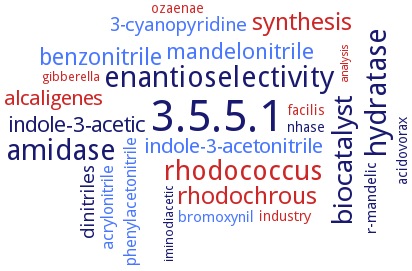3.5.5.1: nitrilase
This is an abbreviated version!
For detailed information about nitrilase, go to the full flat file.

Word Map on EC 3.5.5.1 
-
3.5.5.1
-
enantioselectivity
-
amidase
-
hydratase
-
rhodococcus
-
biocatalyst
-
synthesis
-
rhodochrous
-
benzonitrile
-
mandelonitrile
-
indole-3-acetic
-
alcaligenes
-
indole-3-acetonitrile
-
3-cyanopyridine
-
dinitriles
-
phenylacetonitrile
-
acrylonitrile
-
bromoxynil
-
r-mandelic
-
nhase
-
acidovorax
-
ozaenae
-
facilis
-
industry
-
iminodiacetic
-
gibberella
-
analysis
- 3.5.5.1
-
enantioselectivity
- amidase
-
hydratase
- rhodococcus
-
biocatalyst
- synthesis
- rhodochrous
- benzonitrile
- mandelonitrile
-
indole-3-acetic
- alcaligenes
- indole-3-acetonitrile
- 3-cyanopyridine
-
dinitriles
- phenylacetonitrile
- acrylonitrile
- bromoxynil
-
r-mandelic
- nhase
-
acidovorax
- ozaenae
- facilis
- industry
-
iminodiacetic
- gibberella
- analysis
Reaction
Synonyms
3-cyanopyridinase, acetonitrilase, Arylacetonitrilase, auxin-producing nitrilase, benzonitrilase, benzonitrilase A, benzonitrilase B, bll6402, BrNIT-T, CrNIT1, CrNIT2, cyc705, CynD, humanNIT1, More, nirilase II, NIT, NIT-T2, Nit06, NIT1, Nit1 nitrilase, Nit102, NIT2, NIT3, NIT4A/B1, NIT4A/B2, NitA, NitAk1, nitmc-fb, NitraS-ATII, nitrilase, nitrilase 1, nitrilase AtNIT1, nitrilase bll6402, nitrilase I, nitrile hydratase/amidase, Nlase, PaCNit, SsAH, SSO2122
ECTree
Advanced search results
General Stability
General Stability on EC 3.5.5.1 - nitrilase
Please wait a moment until all data is loaded. This message will disappear when all data is loaded.
efficient biocatalyst recycling is achieved as a result of immobilization with immobilized cells exhibiting 88% conversion even after 20 batch recycles
-
for immobilization of cells with nitrilase activity a variety of sol-gel silica hybrids are tested for entrapment and adsorption of bacterial cells as well as chemical binding on polysulphone membranes. Activation of the matrix surface with formaldehyde leads to an increase in immobilization efficiency and operational stability of the biocatalyst. Among the supports screened, membranes give the best result for enzyme activity and especially operational stability, with retention of 100% activity after eight reaction cycles
-
high recycling efficiency of enzyme ecapsulated in ethyleneamine-mediated biosilica. The residual activity of the enzyme ecapsulated in ethyleneamine-mediated biosilica retains 94.2% of its initial activity after 16 cycles of reaction. Even after 20 cycles, its residual activity keeps approximately 77.1% of its initial activity
maximal nitrilase activity of alginate-immobilized cells is obtained under conditions of 2% (w/v) alginate, 0.6% (w/v) CaCl2, 0.4 g cell/g alginate, and 1.8 mm bead size
-
more resistant to thermal inactivation if cells immobilized in calcium alginate beads, stabilizing effect of 3-cyanopyridine
-
nitrilase aggregates are prepared using ammonium sulfate (35%) precipitation followed by cross-linking with glutaraldehyde (125 mM) which renders 70% activity retention
-
the enzyme ecapsulated in ethyleneamine-mediated biosilica has significantly improved temperature tolerance
the enzyme stability is markedly improved in the presence of D-sorbitol and xylitol (20% w/v), or myo-inositol (10% w/v)
-
the nitrilase activity in cross-linked enzyme aggregates is at 30°C and 60°C about 5times more stable than in soluble preparations
-
the purified native and recombinant enzyme are stabilized by glycine at 1% w/v, sucrose at 10% w/v, D-glucose at 10% w/v, trehalose at 10% w/v, D-sorbitol at 10% w/v, xylitol at 10% w/v, D-myo-inositol at 10%, D-glycerol at 10% w/v, and bovine serum albumin at 0.1-1.0% w/v, in different extents, overview
the recombinant nitrilase (from Escherichia coli strain JM109/pNLE) is quite stable, the residual activity after 10 cycles of reaction is still over 40% of the initial activity


 results (
results ( results (
results ( top
top





